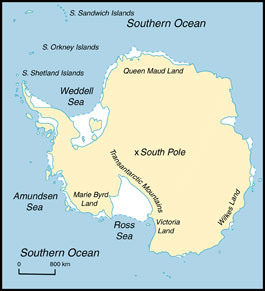Principal Investigators: Brenda Hall, Gideon Henderson (Oxford),
Carlo Baroni (Pisa), and Tom Kellogg
Partially supported by the NOSAMS Laboratory at Woods Hole Oceanographic Institution
The 14C/12C ratio in surface waters of the Southern Ocean is significantly lower than that in the atmosphere due to upwelling of old deep water. This "reservoir age" probably varies in both space and time due to changes in the position and magnitude of such upwelling. Assessment of the recent spatial pattern of natural reservoir ages is made difficult, however, by the presence of significant bomb 14C. Constraining past temporal change is harder still.
Assessment of the pre-bomb and Holocene history of Southern Ocean reservoir ages is an important goal for three principal reasons:

2. Marine sediments in the Southern Ocean provide important information about the paleoceanography of the region but, again, chronology is difficult due to scarcity of information about past reservoir ages. This prevents ready comparison of the timing of events in the Southern Ocean with those elsewhere, so that leads and lags in the climate system cannot be identified.
3. The reservoir age of surface waters is itself a powerful tool with which to assess past ocean circulation. In the same way that the modern distribution of 14C can be used to assess present ocean circulation (e.g. WOCE), knowledge of past 14C distributions provide information about past circulation. In the Southern Ocean, variability in 14C reservoir ages will constrain changes in the rates of upwelling and deep-water formation. Such changes have been hypothesised (Broecker and Sutherland 2000) and, if true, would have significant implications for the mechanisms forcing Holocene climate change.

In this study, we are using paired radiocarbon and U/Th dates of solitary corals to establish a Holocene history of reservoir ages at two localities within the Ross Sea region. These data will afford us the opportunity to reconstruct Holocene changes in the Southern Ocean radiocarbon reservoir.
